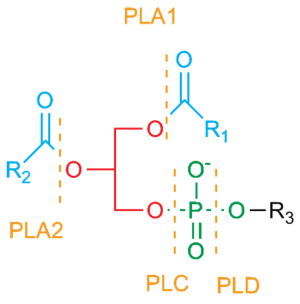Phospholipase
A phospholipase is an enzyme that hydrolyzes phospholipids[1] into fatty acids and other lipophilic substances. There are four major classes, termed A, B, C and D, which are distinguished by the type of reaction which they catalyze:
- Phospholipase A
- Phospholipase A1 – cleaves the SN-1 acyl chain (where SN refers to stereospecific numbering).
- Phospholipase A2 – cleaves the SN-2 acyl chain, releasing arachidonic acid.
- Phospholipase B – cleaves both SN-1 and SN-2 acyl chains; this enzyme is also known as a lysophospholipase.
- Phospholipase C – cleaves before the phosphate, releasing diacylglycerol and a phosphate-containing head group. Phospholipase Cs play a central role in signal transduction, releasing the second messenger inositol triphosphate.
- Phospholipase D – cleaves after the phosphate, releasing phosphatidic acid and an alcohol.

Phospholipase cleavage sites. An enzyme that displays both PLA1 and PLA2 activities is called a Phospholipase B.
Types C and D are considered phosphodiesterases.
Endothelial lipase is primarily a phospholipase.[2]
Phospholipase A2 acts on the intact lecithin molecule and hydrolyses the fatty acid esterified to the second carbon atom. The resulting products are lysolecithin and a fatty acid. Phospholipase A2 is an enzyme present in the venom of bees and viper snakes.[3]
References
- "phospholipase" at Dorland's Medical Dictionary
- Yu JE, Han SY, Wolfson B, Zhou Q (2018). "The role of endothelial lipase in lipid metabolism, inflammation, and cancer". Histology and Histopathology. 33 (1): 1–10. doi:10.14670/HH-11-905. PMC 5858721. PMID 28540715.
- D. M. Vasudevan & S. Sreekumari, Textbook of Biochemistry (5th ed.)
Further reading
- Tappia, Paramjit S. & Dhalla, Naranjan S. (Editors): Phospholipases in Health and Disease. Springer, 2014. ISBN 978-1-4939-0463-1 [Print]; ISBN 978-1-4939-0464-8 [eBook]
External links
| Wikimedia Commons has media related to Phospholipases. |
- Phospholipases at the US National Library of Medicine Medical Subject Headings (MeSH)
This article is issued from Wikipedia. The text is licensed under Creative Commons - Attribution - Sharealike. Additional terms may apply for the media files.